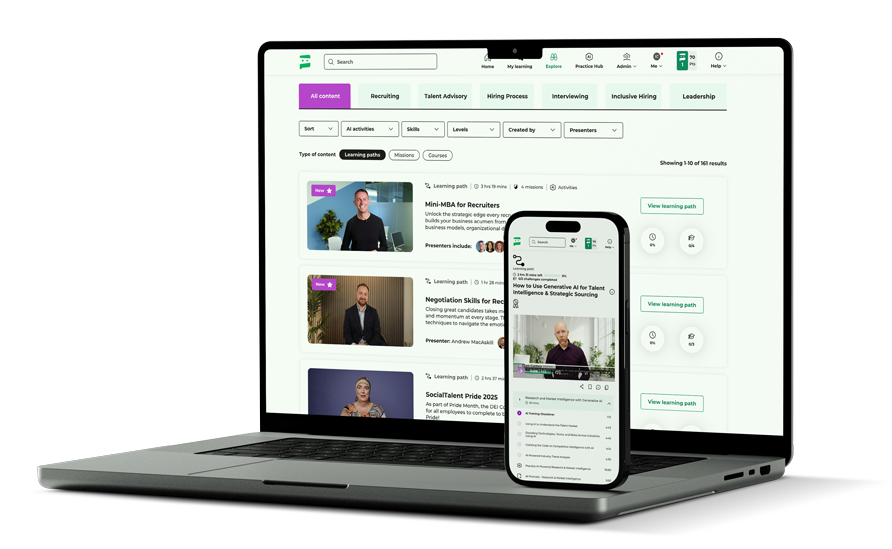
By Johnny Campbell
I’m tired of the “we’ll adopt AI eventually” mindset. That was a safe position two years ago. It isn’t anymore. The question isn’t if AI will reshape recruiting. It’s when (and how fast).
Every industry has had its “Netflix moment.” Some companies jumped in early and rewrote the rules. Others dragged their heels, told themselves it was “too soon,” and collapsed. Recruiting is now staring at its own moment.
We’re moving step by step: from AI sourcing, to interview intelligence, to agentic screeners, to agentic interviewers, and eventually to fully agentic recruiters. The progression is clear. The only question left is whether you’ll seize it—or watch competitors sprint past you.
Stage One: AI Sourcing (Your Obvious First Step)
AI sourcing tools scan millions of profiles in seconds, surfacing hidden talent humans would miss. They predict who might be ready to move, automate shortlists, and free recruiters to focus on actual engagement.
Do this now: Pilot an AI sourcing tool and set a hard 30-day benchmark (reduce time-to-shortlist by at least 30%). If you don’t see results, the problem isn’t the tech—it’s your process.
Blockbuster had the chance to buy Netflix for $50 million in 2000. They laughed it off. Ten years later, they were bankrupt. Don’t be Blockbuster.
Stage Two: Interview Intelligence (Level the Playing Field)
Interview intelligence is recruiting’s equivalent of Gong in sales—it records, nudges, and ensures consistency. It flags when competencies are missed and measures fairness across interviewers.
Candidates are already using AI prep tools. If you’re not counterbalancing with AI intelligence, you’re outgunned.
Do this now: Roll out interview intelligence in one hiring loop. Measure candidate NPS and fairness metrics before vs. after. Watch how quickly hiring managers ask for it in every interview.
Kodak invented the digital camera in 1975. They buried it to protect film sales. Competitors embraced it, and Kodak collapsed. Interview intelligence is today’s digital camera moment. Ignore it at your peril.
Stage Three: The Agentic Screener (Efficiency Without Risk)
Screening is a no-brainer. Most calls are just fact checks (right to work, availability, salary expectations). AI can do it instantly, in multiple languages, without scheduling hassles.
Candidates prefer it too. No wasted 20-minute calls for information they could just input once.
Do this now: Automate initial screens for at least one role family. Free up recruiter time, measure turnaround speed, and check candidate feedback.
This is Borders versus Amazon. Borders outsourced its e-commerce to Amazon in 2001, effectively handing over the future of its business. Amazon leaned into automation and scale. Borders filed for bankruptcy in 2011. In recruiting, if you’re still clinging to manual screens, you’re choosing Borders’ path.
Stage Four: The Agentic Interviewer (First Rounds at Scale)
If AI is already co-piloting interviews, handing it the reins for structured first-rounds is a natural step.
Not for every role (no one’s letting AI run the CFO interview just yet). But for graduates, junior hires, or high-volume positions, AI can already run consistent, bias-reduced interviews, probing intelligently based on responses.
Do this now: Test an AI-led interview for one entry-level role. Compare candidate throughput and manager satisfaction against traditional interviews.
Look at Unilever. They embraced AI for graduate hiring years ago. Time-to-hire dropped by 75%. Diversity outcomes improved. Candidate satisfaction rose. That’s what “early adoption” looks like in action.
Stage Five: The Agentic Recruiter (The Endgame)
The finish line is the fully agentic recruiter—AI sourcing, screening, and interviewing, surfacing the shortlist in minutes. Humans step in only for the highest-value work: advising leaders, building relationships, closing candidates.
This isn’t theory. Startups already offer AI-driven recruiting services that deliver curated shortlists faster than agencies. It’s like tennis shifting from human line judges to automated line-calling. At first it felt radical. Now it’s the default.
Do this now: Don’t wait until competitors are using agentic recruiters as their RPO. Start with controlled trials today. Every month you hesitate, the gap widens.
What Will Always Stay Human
Let’s be clear. AI isn’t here to erase recruiters—it’s here to reshape them.
- Advisory partnership (guiding managers, shaping workforce strategy) will stay human.
- Relationship-building (convincing top candidates to accept) will stay human.
- Complex judgment (weighing culture fit, potential, and nuance) will stay human.
Everything else is up for grabs.
The Takeaways
- Adopt early or fall behind. Netflix, Amazon, Unilever—winners all because they jumped first. Blockbuster, Borders, Kodak—cautionary tales of delay.
- Start small, scale fast. Sourcing, screening, and interview intelligence are low-risk, high-impact starting points.
- Redefine recruiter value. The future recruiter is an advisor, not an administrator. Invest in advisory skills, data literacy, and storytelling.
- Don’t wait for perfection. AI evolves monthly. If you’re waiting for “the perfect tool,” you’ll be left with none.
Final thought: Every TA leader must choose. Are you Netflix or Blockbuster? Amazon or Borders? Kodak or the company that buried them? The future isn’t coming—it’s here. Your competitors are already running with it. If you’re not, you’re falling behind.




